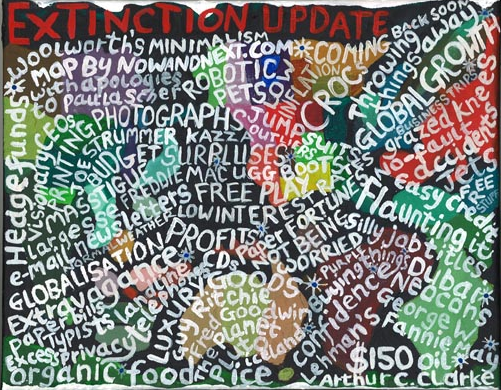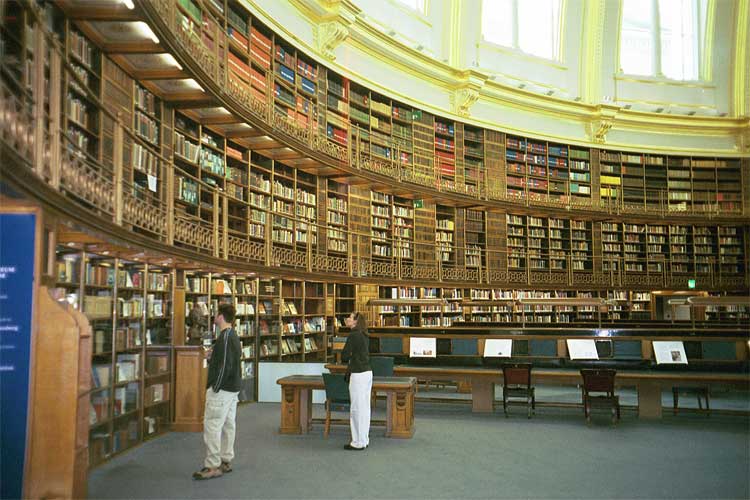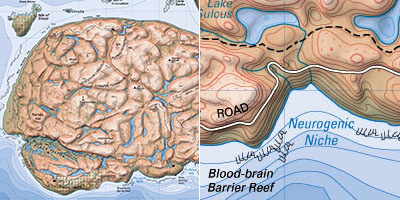
OK, here’s the draft scenario matrix.


OK, here’s the draft scenario matrix.

OK, here’s where we are at. The X-axis on the scenario matrix is pretty set. The driver is the value placed on physical things. This includes library buildings, librarians and books etc.
But the Y-axis? One option is the availability of resources (funding, staff, energy etc). Another option is the level of technology change (fixed v fluid). What we are getting at here, I guess, is the level of uncertainty around e-books in particular and formats in general.
Any views out there in library land?
PS. the image is from the first workshop.

A year or two ago (I can’t remember) I did an extinction timeline looking at familiar things that were set to disappear in the future. The word extinction referred to general rarity rather than total disappearance. Anyway, here’s a 2009 update. Items marked * are expected to come back fairly soon. Note that the original map was created in conjunction with Ross and Jess over a long Christmas lunch.
The list as it currently stands is as follows:
Not being worried
Flaunting it
Low interest rates
Easy credit
Low inflation
Paper fortunes
Minimalism
Hedge funds*
Visionary CEOs (replaced by CFOs)
Printing photographs
Extravagance
Largesse
Budget surpluses
Excess
Privacy
Confidence
Jump suits
Joe Strummer (the Clash — RIP)
$150 oil*
Neocons
Business trips*
Global growth*
Throwing things away*
Kazza
Masstigue
Email newsletters
Dubai*
Silly job titles
Normal weather
Globalisation
Woolworth’s (UK retailer)
Paper bills
Typists
Organic food
Luxury goods*
Guy Ritchie (ex Mr Madonna)
Fred Goodwin (ex CEO of RBS)
The planet Pluto (no longer classified as a planet)
Iceland* (the country)
Ice
Lehman’s
Arthur C. Clarke (RIP)
Fannie May
George W
Profits*
Landline telephones
CDs
Free play (for kids)
Ugg boots
Freddie Mac
Outliers
Purple
Buying things* (we now prefer to rent)
Jets (private)
Free stuff
No-fault accidents
Grazed knees
Crocs
Robotic pets
The link to the map is…also clickable in comments:
http://nowandnext.com/downloads/extinction-timeline-2009-update.jpg
“The moment something has been declared dead, it emerges from the grave like at the end of ‘Carrie’, only more powerful and bigger than ever.” – Douglas Coupland.
So what is currently returning, unexpectedly, from the grave?

In case anyone is interested in the process for this scenario-planning project it is roughly as below. By the way I am not doing this alone. Far from it. Oliver Freeman at NFA is Head of Process (I’m Head of Content apparently) and Cameron M, Ellen F and Leanne P are guiding the rest of the core scenarios team. I will name check everyone in due course.
The process (snack-sized version):
Stage One: Questions
Identifying the set of key framing questions most relevant to the overall achievement of the organisational purpose (as the key focus for this strategic enquiry).
Contextualising in an Issues Report the range of ideas, which will together drive the creation of the Framing Questions for the Scenario Building activity. The main purpose of this initial stage is to frame in precise terms the burning issues and concerns faced by the Library Network and in defining the overarching Framing Question to guide and focus the strategic enquiry.
Stage Two: Environments
Identifying and assessing the major trends, critical uncertainties and predetermined elements whose combinations are shaping future environments using expert-based, trend-based and foresight methodologies.
This stage requires a comprehensive review of the Network’s external environments. Conceptually, it is useful to see any organisation or community as an integrated set of components that are embedded within and separate from an environment of many dynamic factors (natural, social, political, economic, cultural and technological) whose inter-relationships are complex and will create emergent futures.
Stage Three: Scenarios
Creating a set of differentiated scenario worlds in order to identify new opportunities and unforeseen risks associated with these future environments. Part of the set will be a preferred future, which will be built as a consequence of the enquiry launched by Stage 1.
Scenarios provide a framework to develop and evaluate organisational strategies. Scenarios are possible views of the world, providing a context in which executives can make decisions. By seeing a range of possible worlds, decisions will be better informed and a strategy based on this knowledge and insight will be more likely to succeed. The purpose of building scenarios is not to get the future right, as it were, but to stimulate reflection and debate on how strategically to shape the future together.

As you may know I’m involved with a scenario planning project looking at the future of public libraries. Usually these projects are confidential but on this rare occasion I can talk openly about what we are doing and what the scenario team is thinking.
There are about 45 people working on this project although the core scenario building team is much smaller. We have now developed 2 framing questions, which are roughly as follows:
1. What professional skills and attitudes will public library staff be demonstrating in 2030 in order to be successful in the alternative futures in which they might operate?
2. Where will the leadership and funding that drives this success come from?
We have also developed a series of indicative scenarios and briefly discussed around 20 key influences. The next stage is to create some conversations around these influences, edit the influences down to a handful of key drivers and develop a scenario matrix. From this matrix we will then create a series of scenario worlds and create a logical narrative around each scenario.
If anyone out there in library land (or anywhere else) would like to comment or contribute to the long list of key influences this would be most welcome. The list is currently as follows (not ranked):
• Sustainability
• Pricing (free versus user pays)
• Demand for space (third spaces and refuge)
• Media formats (fixed versus fluid)
• Trustworthiness of information
• Changing attitudes to work (especially mobility)
• Funding (high versus low – all sources)
• The value the local community puts on information/knowledge
• Service provision (stand alone versus integrated)
• Demographic change (ageing, ethnic shifts etc)
• Access equity
• Social cohesion / identity
• Democratisation of information (web 2.0 etc)
• Demand for literacy/navigation
• Library network (fragmented versus unified)
• Supply of new professionals
• Staff resistance to change
• Pace of technological change
• Demand for recreational use of libraries
So:have we missed anything? All comments extremely welcome and from anyone.
What am I up to? Today I’m doing a keynote on the future of work at a human resources national convention and then it’s back to work on some scenarios for the future of public libraries. In between I’m doing an update to my book, Future Files, and I’ve just started work on yet another map.
A few people have been asking how I do these maps so I thought I’d start to answer this question. The first stage is a brain dump. I write a list of every significant trend that I can think of. I then dump the trends into categories (lines) on a sheet of very large paper.
The image above is the result of this. The next stage is to look at this information for a month or two and work out what’s wrong with it. What have I missed? What shouldn’t be there? Most of all, how do these lines connect?
Coming soon…a 2009 update to my extinction timeline. It has been done using oil paints so we will have to wait until the paint is dry (about 10 days) before I can scan it. Why oil paints? Why not? There is no strategy behind this. It just is.
” I don’t believe in God, but I miss him” – Julian Barnes

This is quite cool. A 3D map of the human brain. A genuine image of a brain has been mashed up with an elevation model to create contours and some map data from New Zealand has been added to create the offshore islands. Nice. Thanks to Phil btw who found this little gem. More of the same at http://infosthetics.com.